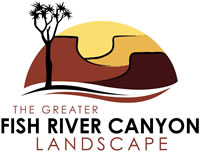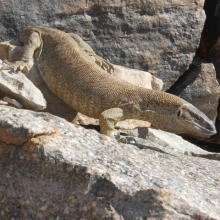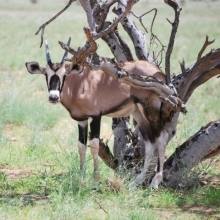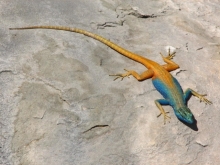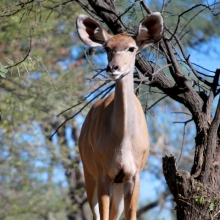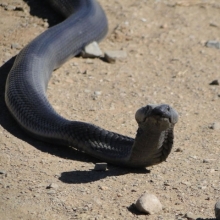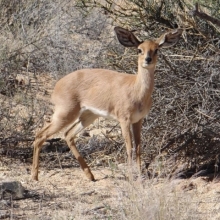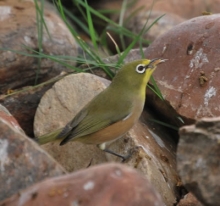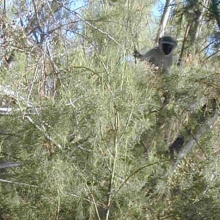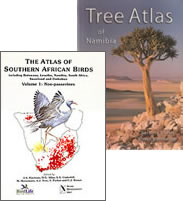Fauna
Until recently (1990s and into the 21st Century) much of the land in the Landscape that falls outside the Ai-Ais National Park was used primarily for small-stock farming. Hunting of wildlife was practiced, usually as a secondary activity, and greatly in excess of sustainable off-takes. As a result, wildlife numbers were severely depressed and many species are locally extinct.
The area is totally unsuited to conventional farming due to its extreme aridity and highly variable rainfall. Because of this and other exacerbating factors, the veld condition on these farms was poor to very poor at the time that the land was converted to wildlife and tourism. The condition of the veld will take many years (probably decades) to fully recover, but signs of recovery are already evident over large areas. Another consequence of small-stock farming was the eradication of predators, and the impacts that gin traps and particularly poisons had on non-target scavengers, both mammals and birds. As a result, a number of important components of the ecosystem have been totally eliminated and others reduced to critically low levels.
Many of the animals have developed special adaptations to enable them to survive in the extremely arid conditions.
Birds
Over 240 bird species have been recorded in the Landscape.
Mammals
The Richtersveld-/Ai-/Ais area is home to at at least 56 species of large mammals, including leopard, Hartmann’s mountain zebra, springbok, gemsbok, red hartebeest, kudu, klipspringer, gemsbok, ostrich, ground squirrel and suricate. The /Ai-/Ais Hot Springs Game Park also contains a relict population of the grey rhebok (Pelea capreolus).
Reptiles and amphibians
The landscape supports a rich reptile diversity. The Richtersveld-/Ai-/Ais area supports a large variety of lizards (35 species) and snakes (16 species).
Relevant literature
-
2003 Game count data
Gondwana Canyon Park Game Count 2003.
Spreadsheet containing the results of the 2003 game count in the Gondwana Canyon Park.» Download -
2004 Game count poster
Gondwana Canyon Park Game Count 2004.
Poster summarising the results of the 2004 game count in the Gondwana Canyon Park.» Download -
2005 Game count poster
Gondwana Canyon Park Game Count 2005
Poster summarising the results of the 2005 game count in the Gondwana Canyon Park.» Download -
2006 Game count presentation
Gondwana Canyon Park Game Count 2006.
Presentation summarising the results of the 2006 game count in the Gondwana Canyon Park.» Download -
2007 Game count presentation
Gondwana Canyon Park Game Count 2007.
Presentation summarising the results of the 2007 game count in the Gondwana Canyon Park.» Download -
2008 Game count poster
Gondwana Canyon Park Game Count 2008
Poster summarising the results of the 2008 game count in the Gondwana Canyon Park.» Download -
2009 Game count poster
Gondwana Canyon Park Game Count 2009
Poster summarising the results of the 2009 game count in the Gondwana Canyon Park.» Download -
2010 Game count poster
Gondwana Canyon Park Game Count 2010
Poster summarising the results of the 2010 game count in the Gondwana Canyon Park.» Download -
2011 Game count poster
Gondwana Canyon Park Game Count 2011
Poster summarising the results of the 2011 game count in the Gondwana Canyon Park.» Download -
2012 Game count poster
Gondwana Canyon Park Game Count 2012
Poster summarising the results of the 2012 game count in the Gondwana Canyon Park.» Download -
2013 Game count poster
Gondwana Canyon Park Game Count 2013
Poster summarising the results of the 2013 game count in the Gondwana Canyon Park.» Download -
Biodiversity zonation of the Greater Fish River Canyon Landscape
Burke, A. 2013. Biodiversity zonation of the Greater Fish River Canyon Landscape. Report of field survey in the Nama Karoo area
As part of a biodiversity zonation for the Greater Fish River Canyon Landscape the summer fieldtrip April-May 2013 targeted six areas, which were selected on the basis of data gaps, representation of the landscape and rainfall patterns. The Orange River mountains proved the most exciting from a plant research perspective, as new distribution records may have been found here.» Download -
Biological characterisation of the Orange-Fish River Basin, Namibia
Irish, J. 2009. Biological characterisation of the Orange-Fish River Basin, Namibia. Report produced for the Ephemeral River Basins in Southern Africa (ERB) Project, Desert Research Foundation of Namibia (DRFN: Windhoek)
Ephemeral River Basins (ERB) in Southern Africa is a project that promotes the sustainable, equitable and improved utilisation of water and other natural resources in ephemeral river basins in southern Africa through the process of integrated resource management (IWRM). Although IWRM is accepted – internationally and regionally – as the approach promoting sustainable management of water resources and the river basin is considered the ideal unit over which to apply it, the basin management approach has not been widely tested and implemented in ephemeral river basins in southern Africa.» Download -
Historic distribution of large mammals in the Greater Fish River Canyon Complex, southern Namibia, and recommendations for re-introductions
Brown, C.J. 2006. Historic distribution of large mammals in the Greater Fish River Canyon Complex, southern Namibia, and recommendations for re-introductions.
This report looks at the historic distribution of larger mammals in the Greater Fish River Canyon Complex of southern Namibia. Based on this information, as well as the present distribution of mammals and the present environmental conditions within and surrounding the Complex, it makes recommendations for the re-introduction and enhancement of large mammal populations.» Download -
Managing biodiversity in the /Ai-/Ais Hotsprings Game Park
Burke, A. 2011. Managing biodiversity in the /Ai-/Ais Hotsprings Game Park. A tool for conservation-, resource- and development planners. EnviroScience & SPAN
The /Ai-/Ais Hotsprings Game Park is the Namibian Section of the /Ai-/Ais/Richtersveld Transfrontier Park (ARTP) in the south of Namibia. Although a joint management plan exists for the Transfrontier Park, detailed information on biodiversity in the Namibian section of the park was lacking. This document addresses this gaps and describes landscape units and their biodiversity importance, highlights knowledge gaps reviews current land uses and proposed zoning and provides guidelines for managing these landscape units.» Download -
Managing biodiversity of the Greater Fish River Canyon Landscape
Burke, A. 2013. Managing biodiversity of the Greater Fish River Canyon Landscape - A tool for sustainable land management. EnviroScience and Namplace, Windhoek, 92 pp
A biodiversity zonation for the Ai-Ais Hotsprings Game Park completed in 2011 was extended to include the Greater Fish River Canyon Landscape. Plants were used as indicators in this conservation planning study, because of the comparatively good information base, their importance for ecological processes and their ready use as indicators at a landscape level.» Download -
Monitoring the reintroduction of Burchell’s zebra in Gondwana Cañon Park
Gosling, M. 2013. Monitoring the reintroduction of Burchell’s zebra in Gondwana Cañon Park
As part of Gondwana Cañon Park’s commitment to enriching the large mammal community of southern Namibia, it reintroduced 26 Burchell’s zebra in July 2006. This report provides an update on the population in 2013.» Download -
Mountain Zebra Project
The purpose of the Mountain Zebra Project is to promote the study of mountain zebras for scientifically based population management and promote them as as a flagship species for wider ecosystem conservation in Namibia. The project is comparing the ecology and behaviour of the species across a variety of habitats and developing study techniques that are useful in sites with different conservation management objectives.» Download -
Mountain Zebra Project – 4th progress report
Gosling, M. 2012. Mountain Zebra Project – 4th progress report. Population ecology of Hartmann’s mountain zebra: comparisons between protected areas in southern Namibia.
This is the fourth progress report on a long-term study of the population ecology, social evolution and conservation of Hartmann’s mountain zebra. The aim of the study is to provide information to help support the conservation of this sub-species in Namibia.» Download -
Species list - birds of Gondwana Canyon Park
Gondwana Canyon Park bird species list
Species list giving common names in English, Afrikaans and German, scientific names, local status and where usually seen» Download -
Species list - large mammals of Gondwana Canyon Park
Gondwana Canyon Park large mammal species list
Species list giving common names in English, scientific names, local status and notes» Download -
Species list - reptiles and amphibians of Gondwana Canyon Park
Reptiles and amphibians of Gondwana Canyon Park
» Download -
Species list - small mammals of Gondwana Canyon Park
Small mammals of Gondwana Canyon Park
» Download
